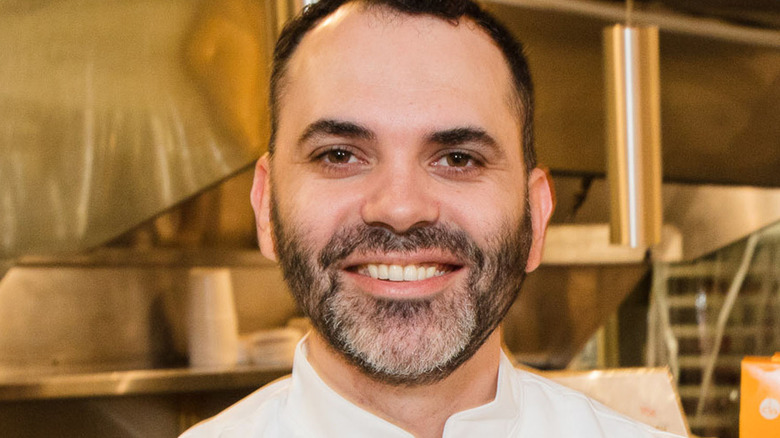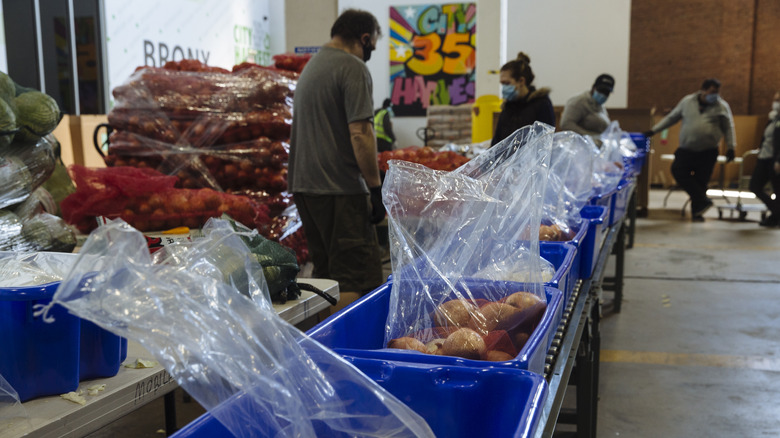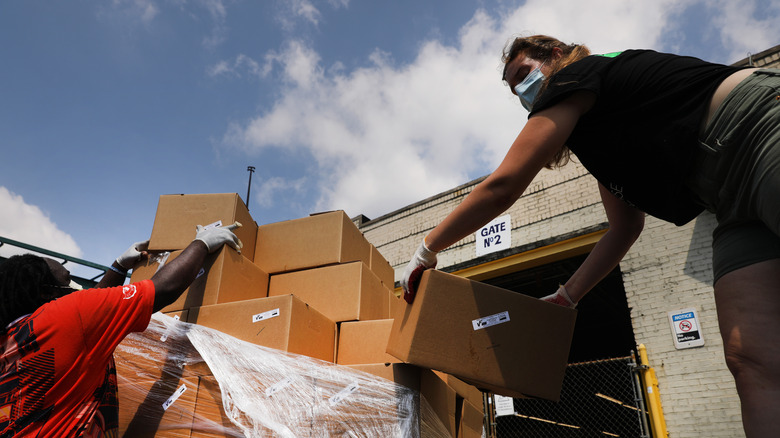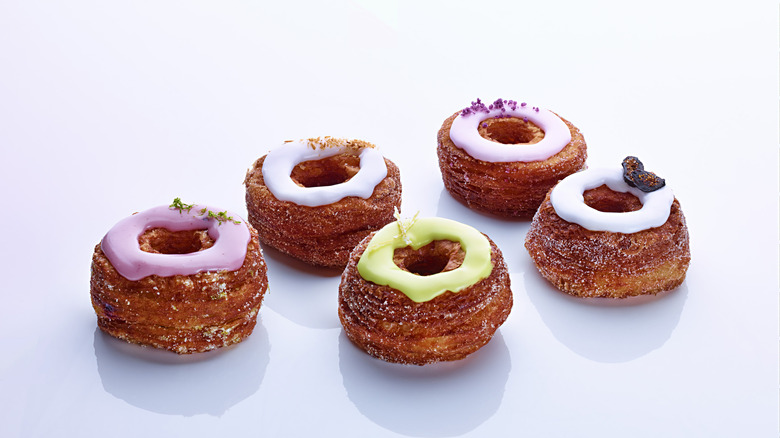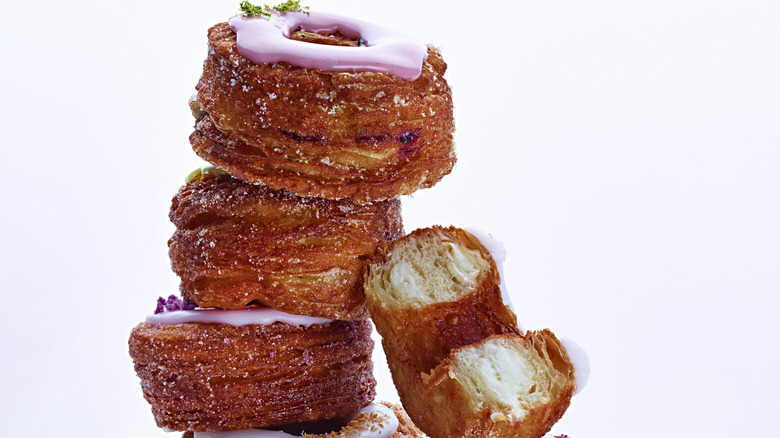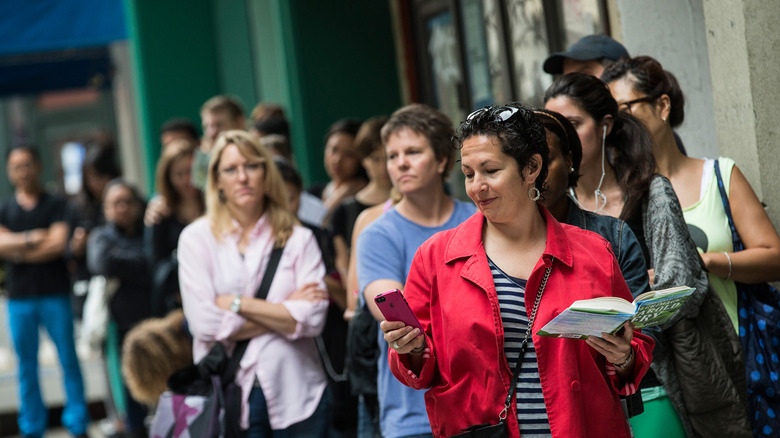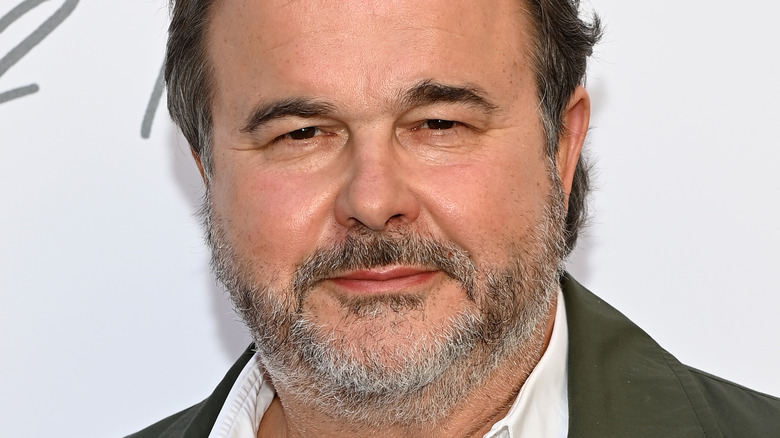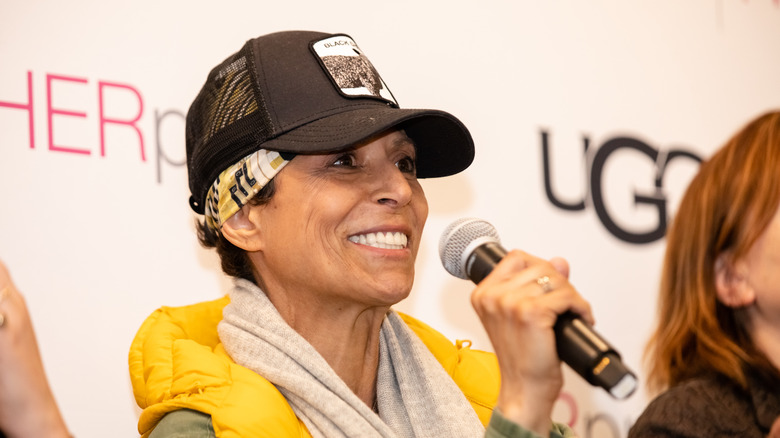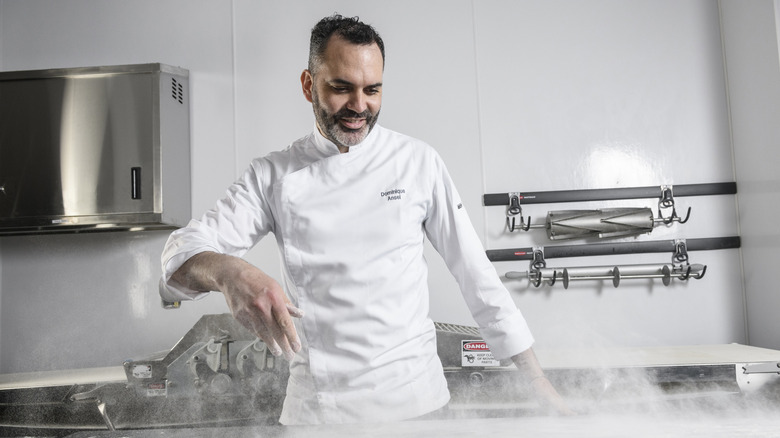Cronut® Creator Pastry Chef Dominique Ansel On Working With City Harvest - Exclusive Interview
If Chef Dominique Ansel sounds familiar, you've probably heard of the 2013 Cronut® phase. Though the delicious hybrid croissant and donut treats became an overnight sensation, they haven't died down since. Ansel currently has shops in Flatiron, Hong Kong, and a new shop launching soon in Las Vegas — in addition to his flagship bakery Dominique Ansel Bakery in SoHo, New York. While the flagship bakery offers Cronuts®, they also have a wide array of hot and cold drinks in addition to offerings like cheesecake, tarts, madeleines, and even savory foods like quiches and paninis.
In addition to being a business owner and renowned pastry chef, Ansel enjoys giving back to the community that has supported him all of these years. Since the pandemic began, food insecurity has skyrocketed — especially in areas like New York City. Many schools have food support programs, but the summer can be an incredibly challenging time for families struggling to procure food. That's where City Harvest comes in. It's the city's first and largest food rescue organization, and Ansel happens to be a council member. In order to help get food to children in need across the city during the summer, Ansel is teaming up with City Harvest for their Share Lunch Fight Hunger initiative. On Saturday, May 21, Dominique Ansel Bakery will donate 10% of sales to the Share Lunch Fight Hunger campaign.
During an exclusive interview with Mashed, Chef Dominique Ansel talked about his work with City Harvest, how people can make a difference in their own communities, and how the bakery helped New Yorkers during the pandemic. He also dished on all things Cronut®, revealed his greatest chef inspirations, and even pitched a dream food TV challenge.
Baking for a cause
On May 21st, Dominique Ansel Bakery will donate 10% of Cronut® sales to City Harvest Share Lunch Fight Hunger. Can you share why you chose this cause and why this issue is so important to you?
I worked in a small town in France. My dad was a factory worker, and we didn't have much growing up. I was the last of four kids. My grandma lived with me, my cousin lived with me, with dog [and] cats — the entire family was living in the same house. In France, you get paid once a month. The end of the month was difficult for my family to put food in their home. I do remember many of those days [when] we didn't have much except bread and scraps and growing up. It was hard for me to understand how food was essential [and] important [in] my life. I started working in the kitchen, and only when I got to New York and actually launched Cronut®, I started remembering all these things that, growing up, it's not obvious [that I haven't] always had food.
It's been a mission of mine to always help bring awareness [about] people who need food, even in a city like New York where there's a lot going on. There [are] a lot of restaurants. There [are] always people that need. I started that even before the Cronut®. When we launched the Cronut®, we raised over $100,000 for charities to fight against hunger. I suffered myself as a kid. [And we raised this money by selling] actually only 24 Cronuts®. [That] was a big eye-opener for me, and I told myself that [it's] important to have help, [and] always to help. I will.
With food insecurity being such a critical issue in the U.S. and around the world, do you have any tips on how people can do their part to combat this epidemic and avoid waste?
Awareness [was] the first step for me, talking about issues about what we, in New York, can do in their own space and how together, [we can be] even stronger. That's why [this] was one of the reasons [I joined] City Harvest because I can [make] the lunch and there [were] people like us to communicate and talk about what we do and why we do it.
Children facing food insecurity
According to the Share Lunch Fight Hunger page, one in four children in the city face food insecurity, which has risen exponentially during the pandemic. Do you have any advice on how people can get involved with fundraising and feeding people going through food insecurity in their own community and schools, especially during the summer?
The best way is always reaching out to groups like City Harvest. They have the resources, they have the communication, [and] they have the means of gathering people and food for people. It is a platform. There's a structure already there. Reaching out, sometimes phone calls, sometimes going there in person, spending a couple hours or a day there with them with the team is really a big eye-opener for everyone.
You're a City Harvest Food council member. What has that position been like? What are some of the greatest things the organization has tackled in the past year?
It's [a] good step to see what we can do as a community of chefs — people that are here to help [and] to [spread] the message of people being in need [and to] help [them]. Also, to not forget we have a bigger mission than being chefs and people. There [are] always things all of us can do. It doesn't matter who we are [or what] we do every day. There [are] always small things that people [can do] — [even to] give their time to go help others. I appreciate that. It's not always easy for everyone, but [I appreciate] doing the step of going forward and doing something.
[People will sometimes] chat to me, "What can I do to help?" or "Is there a donation that you care for that we can [help with]?" I was like, yeah, City Harvest [is] a big part of my life and [a] big part of what I do and who I help. Being a part of helping was important. Communicating and talking about the mission and talking about how people can help, whether it's [donating] money, giving advice, [or] communicating, is always a good thing.
Lending a helping hand during the pandemic
The bakery's also done its part in lending a helping hand during the pandemic. Can you share a bit about that experience?
When the pandemic happened, we actually never closed the bakery. I, like every other business, had to let go [of the] majority of my staff, if not almost everyone. We were bare bones. We had nothing. We opened the shop with two or three people, and it was hard. It was a hard time for everyone. I decided to stay open because our bakery is the center of the community in our neighborhood. [The] bakery is always [a] neighborhood business. I saw, very quickly, after a few weeks, people [came] together, meeting at the bakery because we were one of the only businesses open. I saw people coming from all around town, all around the city, people walking 40, 50 blocks just to come to [the] bakery. I remember that this is how we started — with just a few employees.
We feel humble about being a part of the community, being a part of something bigger than being a business making pastries. We gather people together. On our side, we had a lot of donations going to hospitals to help all the staff — nurses and doctors to support everyone for the hard work, keeping all of us safe. I would say, [we are] back to square one, but with [a] wiser perspective and [a] better understanding of how much we can contribute [to] the community.
What are you able to tell us about the process of creating a Cronut®, and how do you decide on new flavor combinations?
I created the Cronut® back in 2013, and at the time, it was just another creation for the weekend. It was actually prepared for on Mother's Day. That's why the flavor was vanilla and rose. It was a simple addition to the menu. I worked on it for quite some time, because I like the fun interactive perspective [of] the creation, but it was good. I had no idea it was going to go viral and take us all to a different place. Looking back, [it was] a beautiful creation [that] definitely opened doors to so many things.
When it comes to new flavors, we never ever repeated the same flavor, not even once or on the wall. We created over a hundred flavors in New York City and 200 all across the world from all openings. The flavors [are] always based on local culture. [The] ingredients can be spices, tea, [or] coffee. It can be a lot of different integrations of it. We always want something that is tasty. That is good [at] first, and then, something that pairs well with a different flavor. We try to mix a little bit; [for] the texture, we'll do a jam and a cream, and we always try to make it a little bit more unique every single time.
The perfect Cronut® flavor combos
Have there been any flavors that you wanted to try out that ended up not working out?
Not really. There [are] always things that are a little bit more exotic. Sometimes, [we] add spices. There are things that I like [that] I know most people might not like, but sometimes we put a little [of] flavors like herbs and basil and tarragon, which is a little bit more unique for sweets. Usually, we try to make it so [that] everyone is pleased with the flavor, so [it's] still exotic, still unique, still pushing the boundaries, but not too crazy either.
What are some of the best drink and food pairings that people need to try with their Cronut®?
I'll go with, we don't sell any at the bakery, but I'll go with champagne. It's really good with the Cronut®. Otherwise, [a] nice coffee or tea. It's more like breakfast tea items for me [in the] morning, but I know a lot of people like [to] eat that with champagne, and it goes very well.
There's a scene in the "Gilmore Girls" revival that I think about a lot where a journalist, Rory, tries to figure out what makes people so willing to stand in lines for new trends and food creations. What's your take on this phenomenon after creating an innovative and iconic dessert that people still stand in line for in all kinds of conditions?
We don't have hundreds of shops for us. We only have one. It's in New York City, and most importantly, the flavor changes every month. It's a product that is unique. The product is special. A lot of people that have tried it come back because it's good, because it's fun, [and] because it's a new flavor. A lot of people that have never tried it [do so] because it sounds exciting. The combination of flavors and textures is inviting. It's not overwhelming. It's still pretty simple. It's affordable. It's something that you know is [within] everyone's to reach. There [are] hundreds of other reasons why people will come in line in our bakery, but having an approachable and affordable experience is probably one of them.
The wildest line at the bakery
What's the longest line that you've seen? How far have you seen the line go?
That's a good question. I remember this one morning, I was still in the beginning, [and] I had asked one of our baristas to go out and welcome people because customer service is important for me. We're not open yet. It was 7:25 in the morning, and she had left, and so I thought she was going to go see the line and come back. At 7:35, she's not back. 7:45, she's not back. She comes up. I thought she was gone. I thought she probably quit. She's not coming back. She comes back at 7:55. I was like, "[Where] the hell were you? What were you doing?" She's like, "Oh, you told me to go out and say 'hi' to the people in the lines. People started asking me questions, which I had to answer." [I was] like, "Why did it take so long?"
[She was] like, "[I] had to go the end of the line." I was like, "Okay, so what?" She's like, "Have you seen the line outside? It's almost three blocks long." I was like, "What?" The line was three blocks long. She had taken 25 minutes to go out and say "hi" to everyone. She was still working fast, answering people's questions. She came back, and then I was overwhelmed. We had, at the time, only four employees at the bakery. We were very small. My kitchen, it's like ten by six. It's a very, very small kitchen.
We were not prepared for all of this. It was overwhelming. People were not happy because we couldn't make enough of anything. Looking back, it's a very humbling and overwhelming experience, but it's a wonderful one to have the opportunity of starting something like the Cronut® and to open doors to many more things like helping charities. It's a wonderful thing.
Pitching a cooking show
Who are some pastry chefs that you admire and look up to? Is there anyone that you would like to collab with either again or in the future?
I look up to Pierre Hermé in Paris. He was, at the time when I first started in the industry, a little bit before 2000, one of the first ones that [was] really innovating in terms of [the] presentation of the pastries: the combination of flavors, the texture of the pastries. He is a friend of mine. I would love to do something with him. Other than that, a collaboration with Amaury Guichon, [who] is a chef based in Las Vegas, [and a] good friend of mine as well. Cédric Grolet from Paris, who I've done a collab as well here in New York, and all of them [are] very successful. It's always fun to see our friends and fellow chefs come here and do things together.
The world of TV baking is reaching an all-time high, especially with streaming services and shows like, "Is It Cake?" and the engineering infuses show "Baking Impossible." Would you be down to moderate or judge a series like that? And what would your ideal hook be for the show?
I like your questions. I have been invited to be a guest chef and judge [for] different shows. It's always a matter of having the right show and having enough time for myself to go there and do those things. I have a lot of ideas for a challenge. I think it would be cool. I'll give you one. I think it'll be cool to have a challenge with zero gravity. Either you have to eat or build a cake in zero gravity. I think it'll be very difficult, but very fun to watch.
That is such a cool idea. Got to call Netflix for that one.
A dream dinner
Can you tease anything that you're working on now? Any new flavors or new projects that you're working on? Anything like that?
[For] new flavors, [we are] finishing up the next 12 months of flavors of the Cronut®. [We are] still wrapping up quite a bit. We've tasted hundreds of different recipes, a whole year of tasting [for] the Cronut®. We're looking far up until 2023. Other than that, a big project for me, we were opening our shop in Las Vegas, probably early this fall, or end of summer, beginning of fall. I don't have the date yet, but [I'm] super excited about this, building a great team there. It's been nothing but a pleasure to work with that team there.
Is there one chef that you'd love to cook dinner for you?
Yeah. There's many, and I love food. I love eating stuff. She's a friend of mine. I haven't tried her food yet. I love Dominique Crenn, and I would love to go to San Francisco and try her food. I haven't had a chance yet to go, but it's on my list for sure. She's an unbelievable chef and friend and person in general. I love who she is [and] what she does. I would love to try her food.
What's one ingredient that you could never live without?
One ingredient? [There are] so many.
You can pick your top three.
I would say hazelnut. I love hazelnut. I love the flavor of pistachio. I love pistachio, too, and butter, [I] can't live without butter for the rest [of] my life.
An overnight success
Do you have a go-to fast food order, and which restaurant would that be at?
I don't. I don't do well with fast food. I'm not picky, but I love eating good food. That is important for me, so, not fast food, but I like [simpler] food. I'll be happy with a plate of pasta, for example, but good pasta.
What was your reaction to the Cronut® becoming an overnight phenomenon and appearing on "Jeopardy!" and all of these wild things that happened when you were creating it?
Honestly, it's all blurry to me. I feel like it's a movie that you watch, half falling asleep, and you wake up, and you have memories of it. But it was not a movie. It was real, and it was overwhelming. I didn't know what was happening. I didn't understand. I remember that a friend of mine, after we launched the Cronut®, the friend of mine walked in like, "Hey, Dominique, we need to talk. Maybe you should trademark the Cronut®." She was my friend and our lawyer that was trademarking the name of the bakery. I was like, "What are you talking about? Why trademark pastry?" [She was like], "No, no, seriously, let's talk about it. It's going viral. This is [your] net out there. [You] should protect yourself and [your creation]."
At the time, I had no idea of intellectual property, [and] what it means. I learned quickly. We figured it out. She did it for me the next week. There were another 25 applications for the product, and this is when I realized that this was something bigger than I thought. There [are always] industries that want the name of the product. If they trademark before you, they'll prevent you from using it. There's a lot of bullying in this industry, especially with trademarked products. The mass production [companies make] small artists [and] small bakers victims every year. If you don't know, and if you have the luck that I had to have someone to advise me, some things like this [can and will] come up, and you don't realize what's happening.
The Share Lunch Fight Hunger campaign will run until June 3, and New Yorkers can stop by the Dominique Ansel Bakery on May 21 to help the cause. Donations can also be made here. The goal is to raise money to feed 15,000 children and their families during summer break.
